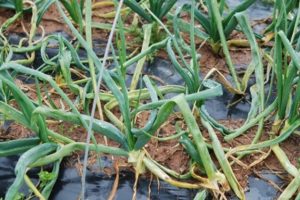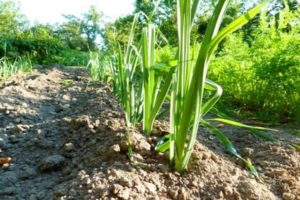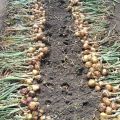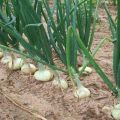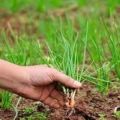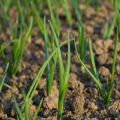The timing of harvesting onions for storage in central Russia and the region
Even experienced summer residents decide every year when it is better to remove onions grown for winter storage in central Russia. The harvest time is influenced by many different factors: variety, planting time, weather, quality of care. Under the same weather conditions, gardeners can harvest onions in neighboring summer cottages with a difference of 1–2 weeks.
Features of harvesting onions
The approximate start date for onion harvesting in the middle zone of the Russian Federation is the end of July (from 20 to 30), early August (from 10 to 15). Turnip harvesting from summer residents of the Moscow Region lasts from July 20 to mid-August. The cultivation of a vegetable is strongly influenced by the weather. In hot, dry weather, the heads mature faster.
What does it depend on and how to determine the timing?
In the Russian Federation, the timing of harvesting onions in different regions differs little. And in the Urals, and in Siberia, and in central Russia, the turnip is removed for storage until mid-August. The exact timing of the maturation of turnip heads depends on additional factors:
- weather conditions of the region;
- the duration of the growing season, planted sevka varieties;
- soil quality;
- planting time of seed or seed.
For any regions of the Russian Federation, the deadline for harvesting the turnip is August 20, as long rains may begin later. They adversely affect the quality of the harvested turnip, make it difficult to clean and dry.
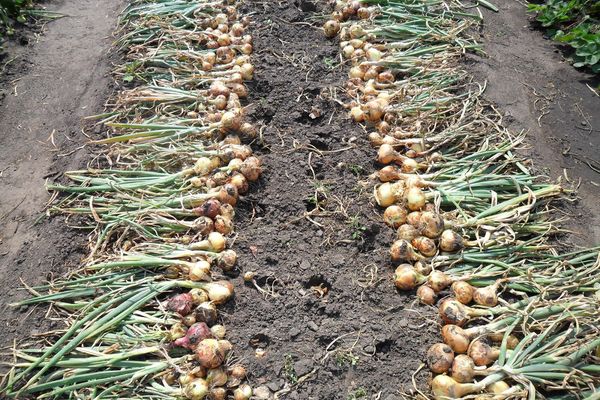
Outwardly
There will be no problems with harvesting a turnip if you know the external signs of its maturity. Onion leaves gradually lose their elasticity and their bright green color. They become tough, tasteless and begin to turn yellow. Closer to mid-July, the new feather is no longer formed, but the old one dries up and lays down on the ground. If 70% of the entire feather is killed, then it's time to start cleaning.
There are other signs of mature bulbs. Most gardeners determine the readiness of the turnip heads for harvesting along the neck of the bulb. It dries completely and becomes flat by the time of cleaning. All nutrients from the feather are transferred to the head. It is covered with integumentary scales of a typical color for this variety.
Due to the cold and rainy summer, onion harvesting in Siberia, and even in central Russia, may be delayed. Gardeners have proven techniques that accelerate the ripening of the bulbs:
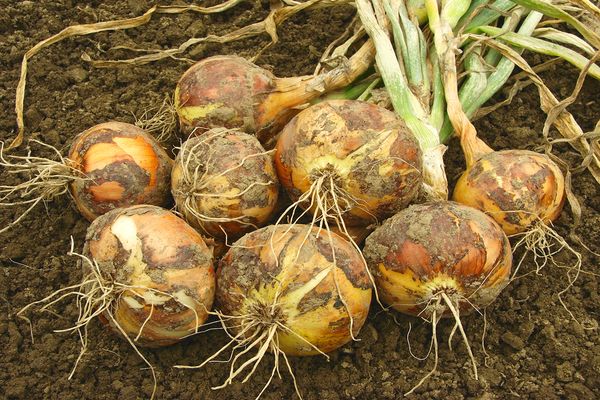
- 7-10 days before the planned harvesting of the turnip, you need to walk along each bed and scrape off the soil from each head with your hand. This technique accelerates the formation of integumentary scales and drying of the neck.
- You can stop feeding the bulbs and speed up their transition to a dormant state with a pitchfork. They need to raise the ground under the heads in order to undermine the roots.
- Instead of a pitchfork, you can use a shovel, it just needs to cut the roots at the heads.
Some summer residents make a gross mistake - they cut off a feather to accelerate ripening. The heads will ripen faster, but at the same time they will lose most of the nutrients, and will be stored worse in winter.
Mathematical method
Lovers of accurate calculations can accurately calculate when to harvest onions... The simplest formula, which rarely fails: we take the planting date as a basis, for example, May 20, counting 75 days from it and get the estimated date for harvesting the bulbs - August 3.
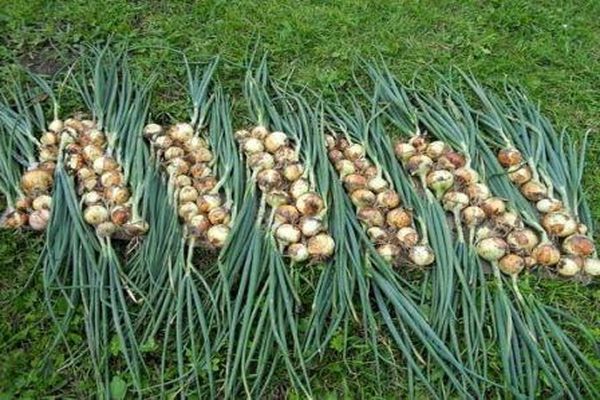
The ripening date of the onion sets can be calculated more accurately if the length of the growing season of a particular variety is taken into account. According to the ripening period, all varieties of seedlings are divided into 4 groups.
| Type of seed variety according to ripening period | Duration of the growing season in days |
| precocious | 90 |
| mid-season | 120 |
| mid-late | 140 |
| late maturing | 150 |
Using mathematical calculations, it is easy to determine when to stop watering the onion beds. Watering ends 2 weeks before the start of cleaning the heads for storage, if it rains often, then 4 weeks before. Simultaneously with watering, they finish loosening the aisles.
Lunar calendar
For many summer residents, the lunar calendar serves as a reference point in any gardening business (sowing, picking, transplanting). They also prefer to harvest bulbs on days marked on the calendar as favorable for harvesting bulbs.
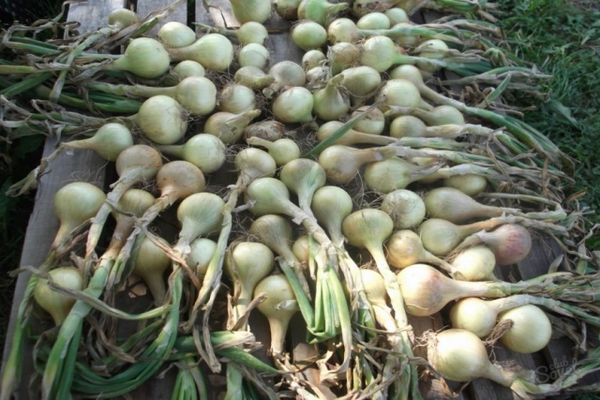
If you follow the lunar calendar, then in 2018 the cleaning and storage of the turnip in the middle lane of the Russian Federation should be started at the beginning of August. In this case, it is imperative to take into account important factors:
- weather;
- the ripening period of a particular seed variety;
- the presence of external signs of ripe bulbs.
The lunar calendar should be taken as additional information for determining the timing of harvesting. Start harvesting based on the real condition of your bow. If you remove the unripe heads according to the lunar calendar, then they will be poorly stored with you and the entire turnip crop may rot during the first months.
If at the beginning of August the tops fell and began to dry out, then your onion has matured and according to the lunar calendar of 2018 it can be harvested starting from August 8, at this time the moon is waning. Unfavorable days for cleaning August 4,5,6,7.
What is the danger of late harvesting of onions?
When onions are harvested ahead of time, storage problems arise. In the middle lane, storage problems can arise if the turnip is pulled out before July 20. Signs of bulbs pulled out ahead of schedule:
- absence or insufficient number of integumentary scales;
- thick neck;
- signs of early spoilage due to the ingress of microbes (fungi) into the head.
It is important to harvest onions for the winter on time, it is worth being a few days late and the heads will be worse stored even at temperatures from 1 to 3 ° C. With late harvesting, the integumentary scales crumble, new roots begin to form in the bulbs, and the heads are affected by infection.
When to trim onions for storage?
Well, if you are lucky with the weather, it should be dry and sunny on the day of cleaning. It is better to start work in the morning. During the day, the torn onion lies on the ridge and dries up. If weather forecasters promise dry weather, then the torn set from the garden can not be removed for 2-3 days, but it is better not to risk it and on the very first day move it under a canopy, where the collected onions will dry for 10 days.
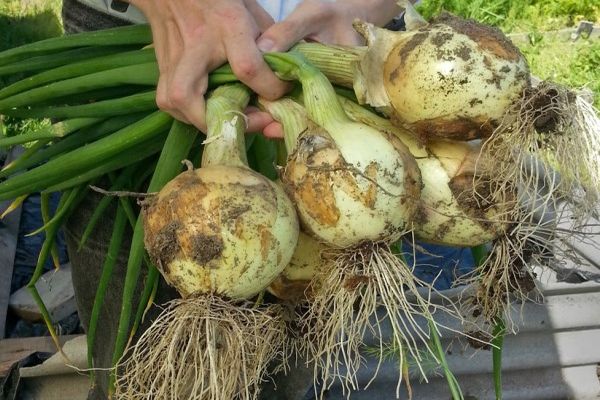
The heads for drying are laid out in one layer, the feather is not cut off. During drying, the heads should be periodically agitated and the condition of the neck should be checked. When it is completely closed, you can start processing the turnip for winter storage:
- first, the bulb must be cleaned with hands from the remnants of the earth;
- shorten the roots with a knife;
- cut off the feather, leaving a tail 5 cm long;
- processed onions, dry for 2-3 days in the sun.
Dry and clean onions can be folded into nets, baskets, plastic boxes, cardboard boxes and put away for storage. Heads with signs of rot, with a damaged base, must be discarded. It makes no sense to send unripe bulbs with a thick neck for storage, it is better to put them on winter preparations or use for preparing salads, first and second courses.

How to determine the ripeness of an onion?
All onion varieties have the same head ripening signs. The first sign is the yellow tips of the leaves at the set. When the feather starts to turn yellow, the size of the turnip no longer increases. The nutrients from the feather are transferred to the head. The neck begins to gradually dry out, the harvesting time of onions is approaching.
At this time, you need to carefully monitor the condition of the onion heads. If the ripe onion is overexposed on the ridge, it can put down new roots and a green feather. This should not be allowed, since such an onion loses its presentation and is stored worse in winter.
Cleaning should be started as soon as the neck bends, and strong cover scales of yellow, white or red color will form on the head.
Conclusion
Choose the right seed varieties for planting, suitable for growing in your area.
A properly selected onion variety guarantees the ripening of the bulbs regardless of weather conditions. Successful varieties for the Moscow region: Belovezhsky, Spassky, Strigunovsky, Robusta. The following varieties grow well in the Urals and Siberia: Red Baron, Exibishen, Odinovets, Danilovskiy 301. The varieties intended for cold regions are distinguished by good keeping quality and cold resistance.
